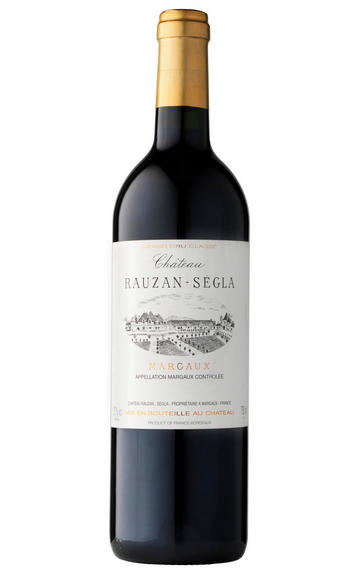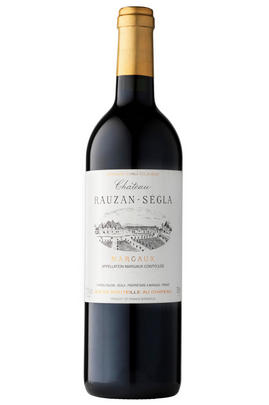
2001 Château Rauzan-Ségla, Margaux, Bordeaux

Critics reviews
The 2001 Rauzan-Ségla shows a little more degradation on the rim, but the nose is fresher than the 2000, offering menthol-tinged black fruit, licorice and earthy scents. The palate is fresh and vibrant with a wonderful line of acidity. This was always snapping at the heels of the 2000 and now appears to have overtaken it in terms of depth and vigor. 12.5% alcohol.
Drink 2021 - 2045
Neal Martin, Vinous.com (September 2021)
Deep garnet-brick colored, the 2001 Rauzan-Ségla rolls out of the glass with open, expressive, mature notes of potpourri, star anise, incense and cigar box with a pretty core of kirsch, redcurrant jelly and dried figs. The light to medium-bodied palate delivers mature spice and dried berry layers with a light grip of chewy tannins and bags of freshness, finishing with a peppery kick.
The blend this year is 63% Cabernet Sauvignon, 34% Merlot and 3% Cabernet Franc, harvested between September 28 and October 11 at an average yield of 46 hectoliters per hectare. It was aged for 18 months in French oak, 50% new. The alcohol is 12.5%.
Drink 2020 - 2027
Lisa Perrotti-Brown, Wine Advocate (April 2020)
About this WINE

Chateau Rauzan-Segla
Château Rauzan-Ségla and Mouton Rothschild were considered the leading 2emé Cru Classé Bordeaux properties during the 19th century. However, while the fortunes of Mouton prospered in the 20th century, culminating in its elevation to 1er Cru status in 1973, Rauzan-Ségla`s reputation dwindled and a succession of disappointing wines were produced.
In the early 80s the Rauzan-Segla was sold and the renaissance began. The eminent Professor Peynaud was appointed as a consultant and the proportion of Cabernet Sauvignon in the blend was increased, as was the proportion of new oak used in the maturation process. In 1986, a brand-new cuverie was built.
A succession of eye-catching wines were produced at Rauzan-Ségla in the mid to late 80s and early 1990s. Rauzan-Segla was bought by Chanel in 1994.
There are now 45 hectares of vineyards at Rauzan-Ségla and the grapes (63% Cabernet Sauvignon, 35% Merlot, 2% Cabernet Franc) are fermented in temperature-controlled, stainless steel tanks. The wine is then matured in barriques (60% new) for 18 months.

Margaux
If Pauillac can be seen as the bastion of ‘traditional’ Red Bordeaux, then Margaux represents its other facet in producing wines that are among Bordeaux’s most sensual and alluring. It is the largest commune in the Médoc, encompassing the communes of Cantenac, Soussans, Arsac and Labaude, in addition to Margaux itself. Located in the centre of the Haut-Médoc, Margaux is the closest of the important communes to the city of Bordeaux.
The soils in Margaux are the lightest and most gravelly of the Médoc, with some also containing a high percentage of sand. Vineyards located in Cantenac and Margaux make up the core of the appelation with the best vineyard sites being located on well-drained slopes, whose lighter soils give Margaux its deft touch and silky perfumes. Further away from the water, there is a greater clay content and the wines are less dramatically perfumed.
Margaux is the most diffuse of all the Médoc appelations with a reputation for scaling the heights with irreproachable wines such as Ch. Margaux and Ch. Palmer, but also plumbing the depths, with too many other châteaux not fulfilling their potential. There has been an upward shift in recent years, but the appellation cannot yet boast the reliability of St Julien. However, the finest Margaux are exquisitely perfumed and models of refinement and subtlety which have few parallels in Bordeaux.
Recommended Châteaux: Ch. Margaux, Ch. Palmer, Ch. Brane-Cantenac, Ch. Rauzan-Ségla , Ch. Dufort-Vivens, Ch. Ferrière, Ch. du Tertre, Ch. Giscours, Ch. d'Angludet.

Cabernet Sauvignon Blend
Cabernet Sauvignon lends itself particularly well in blends with Merlot. This is actually the archetypal Bordeaux blend, though in different proportions in the sub-regions and sometimes topped up with Cabernet Franc, Malbec, and Petit Verdot.
In the Médoc and Graves the percentage of Cabernet Sauvignon in the blend can range from 95% (Mouton-Rothschild) to as low as 40%. It is particularly suited to the dry, warm, free- draining, gravel-rich soils and is responsible for the redolent cassis characteristics as well as the depth of colour, tannic structure and pronounced acidity of Médoc wines. However 100% Cabernet Sauvignon wines can be slightly hollow-tasting in the middle palate and Merlot with its generous, fleshy fruit flavours acts as a perfect foil by filling in this cavity.
In St-Emilion and Pomerol, the blends are Merlot dominated as Cabernet Sauvignon can struggle to ripen there - when it is included, it adds structure and body to the wine. Sassicaia is the most famous Bordeaux blend in Italy and has spawned many imitations, whereby the blend is now firmly established in the New World and particularly in California and Australia.


Buying options
Add to wishlist
Description
Ch. Rauzan-Ségla and Mouton Rothschild were considered the leading Second Growth Bordeaux properties during the 19th century; however, while the fortunes of Mouton prospered in the 20th century, Rauzan-Ségla's reputation dwindled, and a succession of disappointing wines were produced.
In the early 1980s, the property was sold, and the Renaissance began. Now with the might and wealth of Chanel behind this château (since April 1994), the wines here have gone from strength to strength. Rauzan-Ségla is once again worthy of its Second Growth status.
The 2001 vintage is dense with a concentrated cassis nose, supported by graceful fruit and ripe tannins. Despite its power, this has real class, showing elegance, restraint and subtlety. This has all the majesty of great Margaux.
Drink now
Berry Bros. & Rudd (July 2023)
wine at a glance
Delivery and quality guarantee